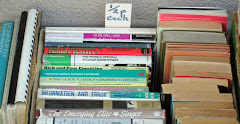
Body Bags installation at ECA, Edinburgh Festival, 2011
Body bags laid out in a row in a studio at Edinburgh Art School looked down on through the window by the grey walls of Edinburgh Castle, was an inspired, if grimly apt juxtaposition: the castle, we must not forget, was built for a military purpose, before it became just a tourist backdrop.
I found this the most moving of the art/poetry shows on offer at this year's Festival: a multi-media installation including sculpture, photographs, poetry and not least, body bags. These latter, of course, remind us of the (mainly) young soldiers, some as young as 18, who have lost their lives, in Iraq, Afghanistan, Northern Ireland, Libya...and continue to do so wherever the wars and their aftermath continues. As the mother of a young man in his early 20s, I found it almost unbearable to contemplate what the mothers of these lads (and sometimes lasses) must feel. This makes one think of British lives, and in Scotland, in particular of the Perthshire and other Scottish regiments deployed overseas, but of course, an exhibition such as this, has a world-wide resonance.
 The Dying Gaul
The Dying GaulAlso, of course, a resonance throughout history as the plaster casts of Classical Greek heroes/warriors, most notably the famous Dying Gaul, from ECA's extensive collection placed strategically throughout the exhibition indicated, along with black and white photographs by Norman MacBeath, and translations into Scots of Simonides' fragments by Robert Crawford, poet and professor of Scottish Literature at St Andrew's university.
Ootlin, tell oor maisters this:/ We lig here deid/ We did as we were telt.
Stranger, tell our masters this: We lie here dead. We did as we were told.
This laconic, possibly ironic, text is typical of the terse, piercing translations by Robert Crawford. Interesting to learn that Simonides is considered to be the first poet who wrote poetry as text and that he wrote about war, terror, loss and anguish, best known for his epitaphs for the Spartan dead at Thermopylae and for friends killed in the Persian Wars (the territories now called Iraq, Iran and Afghanistan): a poet with resonance for our times then.
Simonides can also then be seen as a poet of memory: one of the functions of poetry. His poems are in a way, as Robert Crawford has said, like 'body bags'- containing the remains of a human life.
The pairing of photos and poems send associative resonances between them, at times dramatic, at others oblique and allusive: my favourite, the MacBeath's photo of the inside of a wooden boat and Crawford's Scots/English text:
Waves
The nummer o the swas...
The number of the waves...
To me, the curves of the wooden planks suggested waves, the Greeks rowing their way to war, modern day wars, the dead as numerous as waves... what not said, speaking loud.
There are other photos/poems not ostensibly about war, though maybe speaking of loss, the most striking the photo of a bust of a Greek female head laid on a garden bench, paired with:
Lassie
...the lassie speikin wi her reid, reid mull...
...the girl speaking with her red, red mouth...
You can see this photo reproduced in Giles Sutherland's Times review, and also on his blog (below).
If you did not catch this installation at the Edb. Festival, then this is a must-see at StAnza in March, 2012.
A BBC4 programme can be heard Sunday 4th December or iplayer thereafter for a time.
Read more: http://gilessutherland.blogspot.com/2011/09/body-bags-simonides.html
